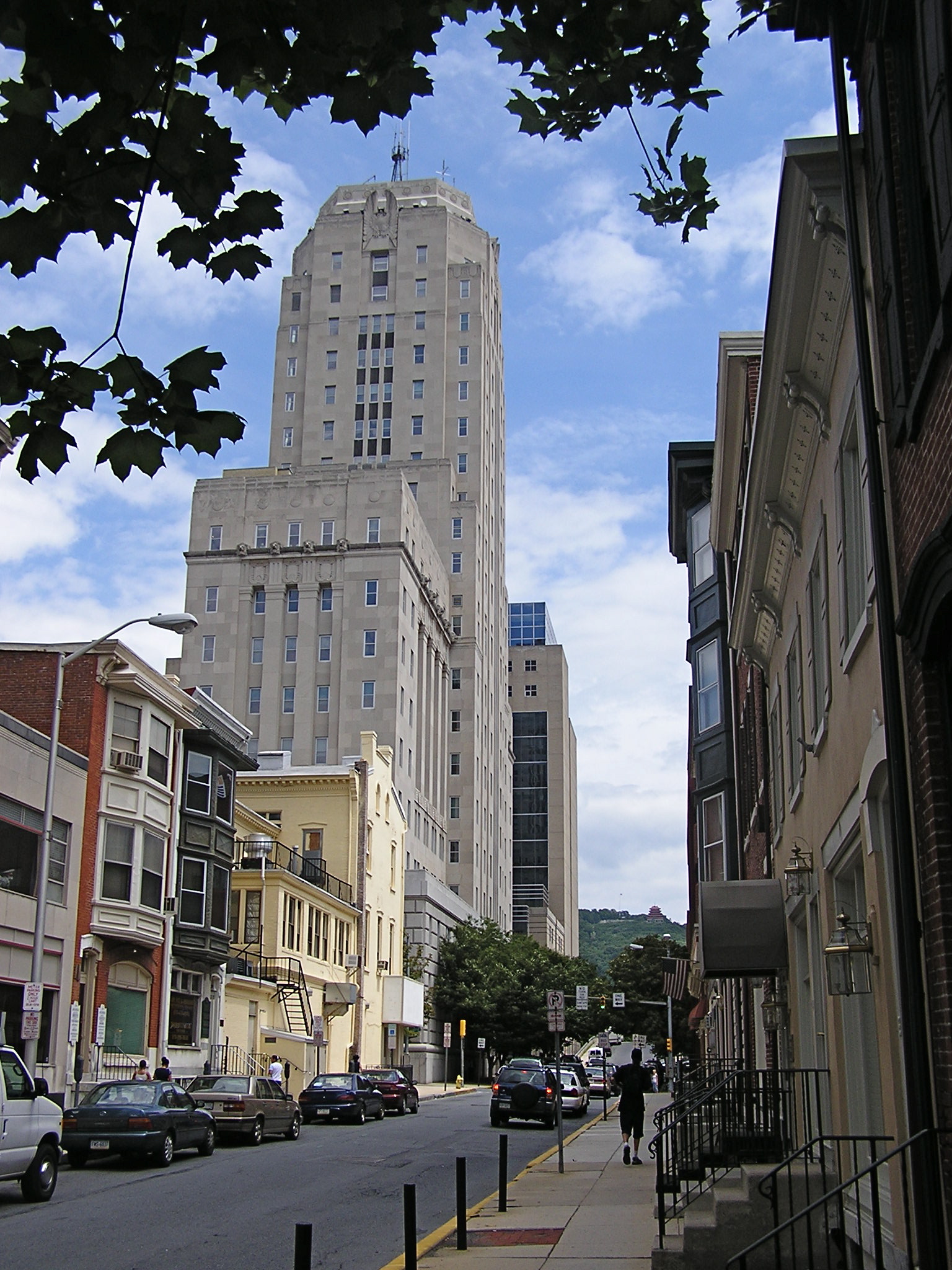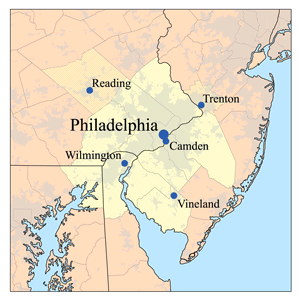|
Astor Theater (Reading, Pennsylvania)
Astor Theater was a historic movie theater located in Reading, Berks County, Pennsylvania, United States. It was designed by architect William Harold Lee in the Art Deco style, and built in 1928. The theater seated 2,478. It operated until 1975, then was demolished in 1998 to clear space for the Sovereign Center arena (since renamed the Santander Arena). Some architectural details, such as the ornate chandelier and gates, were salvaged from the Astor Theatre and recycled in the Sovereign Center. It was listed on the National Register of Historic Places The National Register of Historic Places (NRHP) is the Federal government of the United States, United States federal government's official United States National Register of Historic Places listings, list of sites, buildings, structures, Hist ... in 1978, and delisted in 2000. References External links Astor Theatre, Penn St., Reading, Pennsylvania 1 drawing of theater facade, at Library of Congress Prints and Photograph ... [...More Info...] [...Related Items...] OR: [Wikipedia] [Google] [Baidu] |
Reading, Pennsylvania
Reading ( ; ) is a city in Berks County, Pennsylvania, United States, and its county seat. The city had a population of 95,112 at the 2020 United States census, 2020 census and is the List of municipalities in Pennsylvania, fourth-most populous city in Pennsylvania after Philadelphia, Pittsburgh, and Allentown, Pennsylvania, Allentown. Reading is located in the southeastern part of the state and is the principal city of the Berks County, Pennsylvania, Greater Reading area, which had 420,152 residents in 2020. Reading gives its name to the now-defunct Reading Company, also known as the Reading Railroad and since acquired by Conrail, that played a vital role in transporting anthracite coal from Pennsylvania's Coal Region to major East Coast of the United States, East Coast markets through the Port of Philadelphia for much of the 19th and 20th centuries. Reading Railroad is one of the four railroad properties in the classic U.S. version of the ''Monopoly (game), Monopoly'' board ga ... [...More Info...] [...Related Items...] OR: [Wikipedia] [Google] [Baidu] |
Movie Theater
A movie theater (American English) or cinema (English in the Commonwealth of Nations, Commonwealth English), also known as a movie house, cinema hall, picture house, picture theater, the movies, the pictures, or simply theater, is a business that contains auditoriums for viewing films for public entertainment. Most are commercial operations catering to the general public, who attend by purchasing Ticket (admission), tickets. The film is projected with a movie projector onto a large projection screen at the front of the auditorium while the dialogue, sounds and music are played through a number of wall-mounted speakers. Since the 1970s, subwoofers have been used for low-pitched sounds. Since the 2010s, the majority of movie theaters have been equipped for digital cinema projection, removing the need to create and transport a physical film print on a heavy reel. A great variety of films are shown at cinemas, ranging from animated films to Blockbuster (entertainment), blockbuste ... [...More Info...] [...Related Items...] OR: [Wikipedia] [Google] [Baidu] |
Berks County, Pennsylvania
Berks County (Pennsylvania Dutch language, Pennsylvania Dutch: ''Barricks Kaundi'') is a County (United States), county in the Commonwealth (U.S. state), Commonwealth of Pennsylvania. As of the 2020 United States census, 2020 census, the county's population was 428,849. The county seat is Reading, Pennsylvania, Reading, the List of municipalities in Pennsylvania, fourth-most populous city in the state. The county is part of the South Central Pennsylvania, South Central region of the commonwealth. The county borders Lehigh County, Pennsylvania, Lehigh County to its north, Schuylkill County, Pennsylvania, Schuylkill County to its north, Lebanon County, Pennsylvania, Lebanon and Lancaster County, Pennsylvania, Lancaster counties to its west, Chester County, Pennsylvania, Chester County to its south, and Montgomery County, Pennsylvania, Montgomery County to its east. The county is approximately southwest of Allentown, Pennsylvania, Allentown, the state's third-largest city, and ... [...More Info...] [...Related Items...] OR: [Wikipedia] [Google] [Baidu] |
William Harold Lee
William Harold Lee (December 9, 1884 – February 3, 1971) was an American 20th century movie theater designer and later the chief architect for Eastern College. He was a protégé of acclaimed Philadelphia architect Frank Furness. Lee attended Trinity College for a year, before transferring to the University of Pennsylvania where he studied architecture. During his career, Lee designed numerous theaters and several buildings at Temple University, Franklin and Marshall College. Many of his theaters have only recently begun to receive critical recognition, and while some of his greatest theaters have been demolished, such as the Astor Theater in Reading, Pennsylvania and Victoria Theatre in Shamokin, Pennsylvania. In most cases those which still exist today are being restored. These include the Anthony Wayne in Wayne, Pennsylvania, the Majestic Theatre in Gettysburg, Pennsylvania, the Bryn Mawr Theatre in Bryn Mawr, Pennsylvania, the Hiway Theatre in Jenkintown, Pennsyl ... [...More Info...] [...Related Items...] OR: [Wikipedia] [Google] [Baidu] |
Art Deco Architecture
Art Deco, short for the French (), is a style of visual arts, architecture, and product design that first appeared in Paris in the 1910s just before World War I and flourished in the United States and Europe during the 1920s to early 1930s, through styling and design of the exterior and interior of anything from large structures to small objects, including clothing, fashion, and jewelry. Art Deco has influenced buildings from skyscrapers to cinemas, bridges, ocean liners, trains, cars, trucks, buses, furniture, and everyday objects, including radios and vacuum cleaners. The name Art Deco came into use after the 1925 ( International Exhibition of Modern Decorative and Industrial Arts) held in Paris. It has its origin in the bold geometric forms of the Vienna Secession and Cubism. From the outset, Art Deco was influenced by the bright colors of Fauvism and the Ballets Russes, and the exoticized styles of art from China, Japan, India, Persia, ancient Egypt, and Maya. In its ... [...More Info...] [...Related Items...] OR: [Wikipedia] [Google] [Baidu] |
Sovereign Center
The Santander Arena (formerly known as the Sovereign Center) is a 7,160-seat multi-purpose arena, in Reading, Pennsylvania. It was built in 2001. The arena sits on the former site of the Astor Theater; one of several grand movie and theater palaces built in Reading in the early 20th century. Closed in 1975, the theater sat vacant for over two decades. In 1998, the Astor was demolished to make room for the Santander Arena. Early in construction, steps were taken to retain mementos of the Astor, including its ornate Art Deco chandelier and gates. These are on display and in use inside the arena corridors, allowing insight into the ambience of the former movie house. The Santander Arena is owned by the Berks County Convention Center Authority and managed by ASM Global. In 2000, the Rajah Shrine Theater was purchased, and after a thorough restoration and updating of the facilities was renamed the Sovereign Performing Arts Center. The Reading Eagle Theater is part of the complex. On ... [...More Info...] [...Related Items...] OR: [Wikipedia] [Google] [Baidu] |
National Register Of Historic Places
The National Register of Historic Places (NRHP) is the Federal government of the United States, United States federal government's official United States National Register of Historic Places listings, list of sites, buildings, structures, Historic districts in the United States, districts, and objects deemed worthy of Historic preservation, preservation for their historical significance or "great artistic value". The enactment of the National Historic Preservation Act (NHPA) in 1966 established the National Register and the process for adding properties to it. Of the more than one and a half million properties on the National Register, 95,000 are listed individually. The remainder are contributing property, contributing resources within historic district (United States), historic districts. For the most of its history, the National Register has been administered by the National Park Service (NPS), an agency within the United States Department of the Interior. Its goals are to ... [...More Info...] [...Related Items...] OR: [Wikipedia] [Google] [Baidu] |
Buildings And Structures In Reading, Pennsylvania
A building or edifice is an enclosed structure with a roof, walls and windows, usually standing permanently in one place, such as a house or factory. Buildings come in a variety of sizes, shapes, and functions, and have been adapted throughout history for numerous factors, from building materials available, to weather conditions, land prices, ground conditions, specific uses, prestige, and aesthetic reasons. To better understand the concept, see ''Nonbuilding structure'' for contrast. Buildings serve several societal needs – occupancy, primarily as shelter from weather, security, living space, privacy, to store belongings, and to comfortably live and work. A building as a shelter represents a physical separation of the human habitat (a place of comfort and safety) from the ''outside'' (a place that may be harsh and harmful at times). buildings have been objects or canvasses of much artistic expression. In recent years, interest in sustainable planning and building practi ... [...More Info...] [...Related Items...] OR: [Wikipedia] [Google] [Baidu] |
Art Deco Architecture In Pennsylvania
Art is a diverse range of cultural activity centered around ''works'' utilizing creative or imaginative talents, which are expected to evoke a worthwhile experience, generally through an expression of emotional power, conceptual ideas, technical proficiency, or beauty. There is no generally agreed definition of what constitutes ''art'', and its interpretation has varied greatly throughout history and across cultures. In the Western tradition, the three classical branches of visual art are painting, sculpture, and architecture. Theatre, dance, and other performing arts, as well as literature, music, film and other media such as interactive media, are included in a broader definition of "the arts". Until the 17th century, ''art'' referred to any skill or mastery and was not differentiated from crafts or sciences. In modern usage after the 17th century, where aesthetic considerations are paramount, the fine arts are separated and distinguished from acquired skills in general, ... [...More Info...] [...Related Items...] OR: [Wikipedia] [Google] [Baidu] |
Theatres Completed In 1928
Theatre or theater is a collaborative form of performing art that uses live performers, usually actors to present experiences of a real or imagined event before a live audience in a specific place, often a stage. The performers may communicate this experience to the audience through combinations of gesture, speech, song, music, and dance. It is the oldest form of drama, though live theatre has now been joined by modern recorded forms. Elements of art, such as painted scenery and stagecraft such as lighting are used to enhance the physicality, presence and immediacy of the experience. Places, normally buildings, where performances regularly take place are also called "theatres" (or "theaters"), as derived from the Ancient Greek θέατρον (théatron, "a place for viewing"), itself from θεάομαι (theáomai, "to see", "to watch", "to observe"). Modern Western theatre comes, in large measure, from the theatre of ancient Greece, from which it borrows technical terminolog ... [...More Info...] [...Related Items...] OR: [Wikipedia] [Google] [Baidu] |







